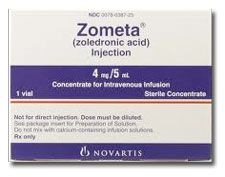Publication
Article
Oncology & Biotech News
Denosumab Has Lower NNT Versus Zoledronic Acid for Prevention of SREs
Author(s):
Fewer cancer patients need to be treated with denosumab to prevent one skeletal-related event due to bone metastases from solid tumors.

Fewer cancer patients need to be treated with denosumab to prevent one skeletal-related event (SRE) due to bone metastases from solid tumors (with the exception of breast, prostate, or multiple myeloma tumors), according to data presented at the ASCO meeting in June.
For the primary endpoint of time to first on-study SRE, the number of patients needed to be treated to prevent 1 SRE with denosumab versus zoledronic acid was 7.8. For denosumab versus placebo, the number needed to treat (NNT) was 3.3. To prevent multiple SREs, the NNT for denosumab versus zoledronic acid was 6.5.
“A lower NNT represents a more effective treatment,” said lead author Gary Richardson, MD, of Cabrini Hospital in Malvern, Australia, and colleagues. “NNT provides a clinically useful measure of the relative benefits of 2 treatments. These low values for NNT demonstrate the high therapeutic efficacy of denosumab.”
Bone metastases are a frequent complication of cancer, and increase the likelihood of experiencing an untoward SRE (ie, pathologic fracture) requiring radiation or surgery to the bone, and perhaps causing spinal cord compression. Bisphosphonates are used to delay and prevent SREs, but despite bisphosphonate treatment, SREs can still occur. Denosumab is approved for the prevention of SREs in patients with solid tumors and bone metastases. This drug is specific for RANK ligand, which blocks osteoclast formation, function, and survival, and thereby interrupts the vicious cycle of cancer-related bone destruction.

Zoledronic acid, a bisphosphonate approved for treatment of bone metastases in patients with solid tumors, requires dose adjustments for every infusion to prevent renal toxicity. Denosumab is easier to administer and is given subcutaneously (SC), not intravenously (IV).
The international, double-blind, activecontrolled phase III trial randomized 1776 patients with solid tumors other than breast cancer, prostate cancer, or multiple myeloma to receive denosumab 120 mg SC and placebo IV every 4 weeks or zoledronic acid 4 mg IV and placebo SC every 4 weeks. All patients got supplemental calcium and vitamin D.
To estimate the NNT for denosumab versus zoledronic acid, the calculation was the inverse of the difference of the annualized or patientyear adjusted rates of SRE between the 2 treatments. The NNT calculation for denosumab versus placebo for time to first on-study SRE was made based on results of the placebo-registered studies of zoledronic acid.
In one clinical trial comparing denosumab versus zoledronic acid, denosumab was superior in preventing SREs in patients with solid tumors only (P = .001, not breast, prostate, or multiple myeloma). In a second clinical trial, denosumab was noninferior to zoledronic acid in preventing first and subsequent SREs in patients with solid tumors (not breast or prostate tumors) and bone metastases or multiple myeloma.
Richardson GE, Ciuleanu TE, Costa L, et al. Denosumab versus zoledronic acid in patients with bone metastases from solid tumors other than breast and prostate cancers or multiple myeloma: a number needed to treat analysis. J Clin Oncol. 2011;29(suppl; abstr 9115).










